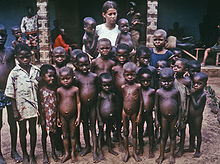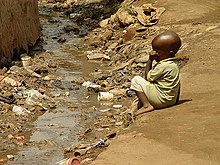Stunted growth: Difference between revisions
| Line 15: | Line 15: | ||
Research on a global level has found that the proportion of stunting that could be attributed to five or more episodes of diarrhoea before two years of age was 25%.<ref>{{cite journal|last1=Walker|first1=Christa L Fischer|last2=Rudan|first2=Igor|last3=Liu|first3=Li|last4=Nair|first4=Harish|last5=Theodoratou|first5=Evropi|last6=Bhutta|first6=Zulfiqar A|last7=O'Brien|first7=Katherine L|last8=Campbell|first8=Harry|last9=Black|first9=Robert E|title=Global burden of childhood pneumonia and diarrhoea|journal=The Lancet|date=April 2013|volume=381|issue=9875|pages=1405–1416|doi=doi:10.1016/S0140-6736(13)60222-6|url=http://www.thelancet.com/journals/lancet/article/PIIS0140-6736(13)60222-6/fulltext#article_upsell}}</ref> Since diarrhoea is closely linked with water, sanitation and hygience ([[WASH]]), this is a good indicator for the the connection between WASH and stunted growth. The understanding of the complex interdependence between nutrition, stunted growth and WASH has increased in recent years. |
Research on a global level has found that the proportion of stunting that could be attributed to five or more episodes of diarrhoea before two years of age was 25%.<ref>{{cite journal|last1=Walker|first1=Christa L Fischer|last2=Rudan|first2=Igor|last3=Liu|first3=Li|last4=Nair|first4=Harish|last5=Theodoratou|first5=Evropi|last6=Bhutta|first6=Zulfiqar A|last7=O'Brien|first7=Katherine L|last8=Campbell|first8=Harry|last9=Black|first9=Robert E|title=Global burden of childhood pneumonia and diarrhoea|journal=The Lancet|date=April 2013|volume=381|issue=9875|pages=1405–1416|doi=doi:10.1016/S0140-6736(13)60222-6|url=http://www.thelancet.com/journals/lancet/article/PIIS0140-6736(13)60222-6/fulltext#article_upsell}}</ref> Since diarrhoea is closely linked with water, sanitation and hygience ([[WASH]]), this is a good indicator for the the connection between WASH and stunted growth. The understanding of the complex interdependence between nutrition, stunted growth and WASH has increased in recent years. |
||
== Epidemiology == |
|||
UNICEF has estimated that: "Globally, more than one quarter (26 per cent) of children under 5 years of age were stunted in 2011 – roughly 165 million children worldwide." and "In sub-Saharan Africa, 40 per cent of children under 5 years of age are stunted; in South Asia, 39 per cent are stunted." The four countries with the highest prevalence are Timor-Leste, Burundi, Niger and Madagascar where more than half of children under 5 years old are stunted. |
|||
== Ways to reduce stunting == |
== Ways to reduce stunting == |
||
The 2013 Lancet series or articles on maternal and child nutrition confirmed that to reduce stunting three things are needed:<ref>{{Cite web|url = http://www.thelancet.com/series/maternal-and-child-nutrition|title = The Lancet series on Maternal and Child Nutrition|date = 6 June 2013|accessdate = 8 November 2014|website = |publisher = The Lancet|last = |first = }}</ref> |
The 2013 Lancet series or articles on maternal and child nutrition confirmed that to reduce stunting three things are needed:<ref>{{Cite web|url = http://www.thelancet.com/series/maternal-and-child-nutrition|title = The Lancet series on Maternal and Child Nutrition|date = 6 June 2013|accessdate = 8 November 2014|website = |publisher = The Lancet|last = |first = }}</ref> |
||
Revision as of 22:58, 9 November 2014




Stunted growth or stunting is a reduced growth rate in human development. It is a primary manifestation of malnutrition and diseases, such as recurrent diarrhea and helminthiasis, in early childhood, including malnutrition during fetal development brought on by the malnourished mother. According to the latest UN estimates, an estimated 162 million children under 5 years of age, or 25%, were stunted in 2012. More than 90% of the world's stunted children live in Africa and Asia, where respectively 36% and 56% of children are affected.[1] Once established, stunting and its effects typically become permanent. Stunted children may never regain the height lost as a result of stunting, and most children will never gain the corresponding body weight. It may also lead to premature death later in life because vital organs never fully develop during childhood. Living in an environment where many people defecate in the open due to lack of sanitation, is an important cause of stunted growth in children, for example in India.[2]
Diagnosis
Growth stunting is identified by comparing measurements of children's heights to the World Health Organization 2006 growth reference population: children who fall below the fifth percentile of the reference population in height for age are defined as stunted, regardless of the reason. As an indicator of nutritional status, comparisons of children's measurements with growth reference curves may be used differently for populations of children than for individual children. The fact that an individual child falls below the fifth percentile for height for age on a growth reference curve may reflect normal variation in growth within a population: the individual child may be short simply because both parents carried genes for shortness and not because of inadequate nutrition. However, if substantially more than 5% of an identified child population have height for age that is less than the fifth percentile on the reference curve, then the population is said to have a higher-than-expected prevalence of stunting, and malnutrition is generally the first cause considered.
Causes
Whilst the principal cause for stunted growth in children used to be regarded as simply malnutrition, there is increasing agreement that lack of sanitation (open defecation) and associated diseases, such as recurrent diarrhoea, intestinal worm infections (helminthiasis) and tropical enteropathy (also called environmental enteropathy) all are important causes, too.[3]
Research on a global level has found that the proportion of stunting that could be attributed to five or more episodes of diarrhoea before two years of age was 25%.[4] Since diarrhoea is closely linked with water, sanitation and hygience (WASH), this is a good indicator for the the connection between WASH and stunted growth. The understanding of the complex interdependence between nutrition, stunted growth and WASH has increased in recent years.
Epidemiology
UNICEF has estimated that: "Globally, more than one quarter (26 per cent) of children under 5 years of age were stunted in 2011 – roughly 165 million children worldwide." and "In sub-Saharan Africa, 40 per cent of children under 5 years of age are stunted; in South Asia, 39 per cent are stunted." The four countries with the highest prevalence are Timor-Leste, Burundi, Niger and Madagascar where more than half of children under 5 years old are stunted.
Ways to reduce stunting
The 2013 Lancet series or articles on maternal and child nutrition confirmed that to reduce stunting three things are needed:[5]
- an enabling environment for political commitment
- a scaled-up series of cost-effective nutrition interventions
- robust underlying drivers (food security, empowered women and a supportive health environment through increasing access to safe water and sanitation).
To prevent stunting, it is not just a matter of providing better nutrition but also access to clean water, improved sanitation (hygenic toilets) and hand washing at critical times (summarised as "WASH"). Prevention of tropical intestinal diseases which may affect almost all children in the developing world, is thought to be important to normalise child growth, and that this will not be possible without provision of toilets.[6]
Studies have looked at ranking the underlying determinants in terms of their potency in reducing child stunting and found in the order of potency:[7]
- percent of dietary energy from non-staples (greatest)
- access to sanitation and women’s education
- access to safe water
- women’s empowerment as measured by the female-to-male life expectancy ratio
- per capita dietary energy supply
Three of these determinants should be of particular focus: access to sanitation, diversity of calorie sources from food supplies, and women’s empowerment. The first two should be prioritized because they have strong impacts yet are farthest below their desired levels.[7]
The goal of UN agencies, governments and NGO is now to optimise nutrition during the first 1000 days of a child’s life, from pregnancy to the child’s second birthday, and therefore reduce the prevalence of stunting. The first 1000 days in a child's life are crucial because the brain develops rapidly, laying the foundation for future cognitive and social ability. Furthermore, it is also the time when young children are the most susceptible to infections that lead to diarrhoea, when they begin the weaning process, begin to crawl and become exposed to faecal matter from open defecation and environmental enteropathies.
Examples
The Water and Sanitation Program of the World Bank has investigated links between lack of sanitation and stunting in Vietnam and Lao PDR.[8] For example in Vietnam it was found that lack of sanitation in rural villages in mountainous regions of Vietnam led to five-year-old children being 3.7 cm shorter than healthy children living in villages with good access to sanitation.[9] This difference in height is irreversible and matters a great deal for a child’s cognitive development and future productive potential.
One study conducted in a rural area in Zimbabwe illustrates the impact malnutrition has on growth. The area is known for poor farming conditions and prevalent malnourishment. Children ages 6–17 in the area were assessed for height, weight, and body mass index (BMI). The data recorded was compared with both American and other African countries average heights. Compared with the American averages, the Zimbabwean boys' height and weight dropped as low as the 10th percentile in some age groups and showed no sign of catch-up growth during the mid-teens. Zimbabwean girls' height and weight were not as low, but did drop as low as the 25th percentile. However, catch-up growth did occur during mid-teens and by 16 and 17, the girls average was close to the 50th percentile. Olivier, Semproli, Pettener, and Toselli, sums it up by saying that "the adverse socioeconomic environment and the low levels of food availability compromise and probably delay the physical development of the affected children in all phases of growth." Also, these data support the theory that lower than average size at early ages could be due to an adaptive mechanism reacting to low food intake.[10]
See also
References
- ^ United Nations Children's Fund, World Health Organization, The World Bank. UNICEFWHO- World Bank Joint Child Malnutrition Estimates. (http://data.unicef.org/resources/2013/webapps/nutrition)
- ^ Spears, D. (2013). How much international variation in child height can sanitation explain? - Policy research working paper. The World Bank, Sustainable Development Network, Water and Sanitation Program
- ^ Velleman, Y., Pugh, I. (2013). Under-nutrition and water, sanitation and hygiene - Water, sanitation and hygiene (WASH) play a fundamental role in improving nutritional outcomes. A successful global effort to tackle under-nutrition must include WASH. WaterAid and Share, UK
- ^ Walker, Christa L Fischer; Rudan, Igor; Liu, Li; Nair, Harish; Theodoratou, Evropi; Bhutta, Zulfiqar A; O'Brien, Katherine L; Campbell, Harry; Black, Robert E (April 2013). "Global burden of childhood pneumonia and diarrhoea". The Lancet. 381 (9875): 1405–1416. doi:doi:10.1016/S0140-6736(13)60222-6.
{{cite journal}}: Check|doi=value (help) - ^ "The Lancet series on Maternal and Child Nutrition". The Lancet. 6 June 2013. Retrieved 8 November 2014.
- ^ Humphrey, JH (19 September 2009). "Child undernutrition, tropical enteropathy, toilets, and handwashing". Lancet. 374 (9694): 1032–5. PMID 19766883.
- ^ a b Smith, L. and Haddad, L. (2014) Reducing Child Undernutrition: Past Drivers and Priorities for the Post-MDG Era, IDS Working Paper 441, IDS (Institute for Development Studies), UK
- ^ Maria Quattri, Susanna Smets, and Viengsompasong Inthavong (2014) Investing in the Next Generation - Children grow taller, and smarter, in rural, mountainous villages of Lao PDR where all community members use improved sanitation, WSP (Water and Sanitation Program), World Bank, USA
- ^ Maria Quattri, Susanna Smets, and Minh Thi Hien Nguyen (2014) Investing in the Next Generation - Children grow taller, and smarter, in rural, mountainous villages of Vietnam where community members use improved sanitation, WSP (Water and Sanitation Program), World Bank, USA
- ^ Olivieri, F., Semproli, S.,Pettener, D., & Toselli, S. (2007). Growth and malnutrition of rural zimbabwean children (6-17 years of age). American Journal of Physical Anthropology, 136(2), 214-222. doi:10.1002/ajpa.20797
Template:Symptoms concerning nutrition, metabolism and development
